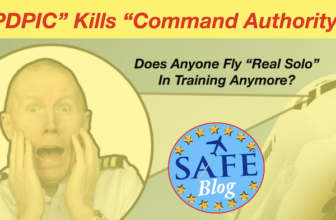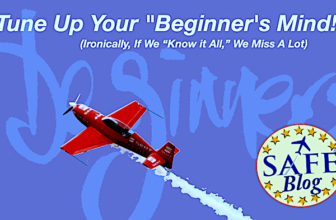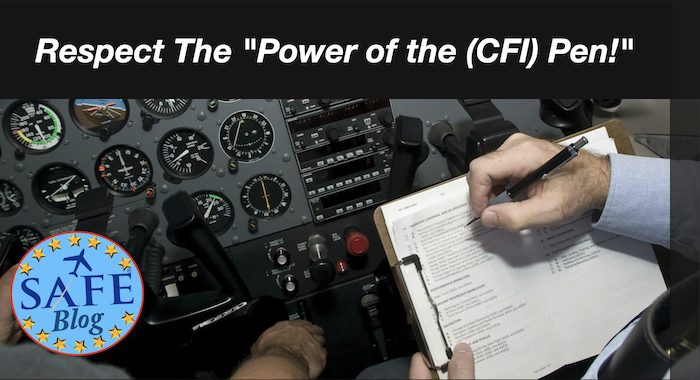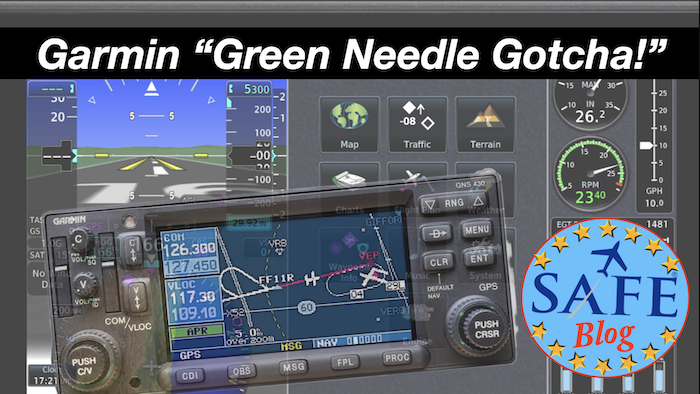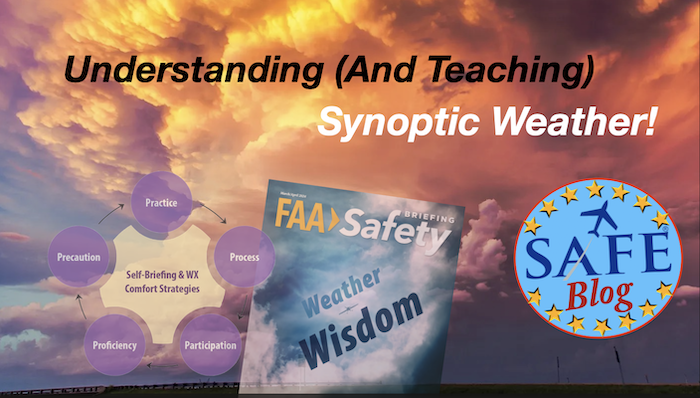
[ad_1]
 Safety in any field requires understanding accident trends but also digging deeper to reveal root causes. For example, the fatal accident rate for automobiles has continued to decrease, but the number of accidents is still increasing. Pedestrian and impaired driving accidents have increased exponentially. If you get beneath the obvious fatal accident good news, people are probably driving faster and more recklessly. The reduced fatal rate is probably a result of amazing vehicle safety technology (and improved first responders) saving a lot of lives. Many times “the numbers” are only good on the surface; look for root causes.
Safety in any field requires understanding accident trends but also digging deeper to reveal root causes. For example, the fatal accident rate for automobiles has continued to decrease, but the number of accidents is still increasing. Pedestrian and impaired driving accidents have increased exponentially. If you get beneath the obvious fatal accident good news, people are probably driving faster and more recklessly. The reduced fatal rate is probably a result of amazing vehicle safety technology (and improved first responders) saving a lot of lives. Many times “the numbers” are only good on the surface; look for root causes.
 In aviation, we have a similar enigma. Though we have more real-time weather information on our phones and tablets (and commonly en route wx), most pilots seem to be ignorant of the larger forces behind the displays. Many pilots utilize surface weather information like a video game – “avoid and divert” – without understanding the larger atmospheric forces behind the displays. We resemble doctors treating the symptoms while ignoring the root causes; bad medicine. Modern pilots are not savvy analysts, they fly like mice in a maze – and many seem to be continually surprised as well. This is not strategic weather planning, it is reacting to surprises as they occur. This reveals a serious lack of weather knowledge and experience in our aviation community which is the root cause of most accidents.
In aviation, we have a similar enigma. Though we have more real-time weather information on our phones and tablets (and commonly en route wx), most pilots seem to be ignorant of the larger forces behind the displays. Many pilots utilize surface weather information like a video game – “avoid and divert” – without understanding the larger atmospheric forces behind the displays. We resemble doctors treating the symptoms while ignoring the root causes; bad medicine. Modern pilots are not savvy analysts, they fly like mice in a maze – and many seem to be continually surprised as well. This is not strategic weather planning, it is reacting to surprises as they occur. This reveals a serious lack of weather knowledge and experience in our aviation community which is the root cause of most accidents.
 There are several simple solutions, both for the pilot and for the educator. All these involve education and practice. If you want to be a savvy aviator, a good strategy is to analyze the aviation weather challenges every day; focus on the larger forces driving the weather. At a minimum, read the NWS Aviation Forecast in textual form (also available on ForeFlight in the “TAF” tab). Then present yourself with the hypothetical challenge of making a trip from point A to B *every day* even if you are not really planning to go anywhere. (enter into ForeFlight map and send to “Flights” for a briefing). Analyze the weather in real-time without the emotional baggage of “I want to get there.” This will develop both your technological toolkit for accurate information gathering, *and* sharpen your personal weather system (and honesty). ForeFlight has a great “first look” toolkit, but has more goodness when you dig beneath the surface. If the weather is complex (opportunity), dig much deeper using the resources below.
There are several simple solutions, both for the pilot and for the educator. All these involve education and practice. If you want to be a savvy aviator, a good strategy is to analyze the aviation weather challenges every day; focus on the larger forces driving the weather. At a minimum, read the NWS Aviation Forecast in textual form (also available on ForeFlight in the “TAF” tab). Then present yourself with the hypothetical challenge of making a trip from point A to B *every day* even if you are not really planning to go anywhere. (enter into ForeFlight map and send to “Flights” for a briefing). Analyze the weather in real-time without the emotional baggage of “I want to get there.” This will develop both your technological toolkit for accurate information gathering, *and* sharpen your personal weather system (and honesty). ForeFlight has a great “first look” toolkit, but has more goodness when you dig beneath the surface. If the weather is complex (opportunity), dig much deeper using the resources below.
 Safety dictates that every weather analysis should be a very objective yes/no decision based on facts (not emotions). It is critical to identify and avoid our usual cognitive biases of “want and hope!” Performing a weather analysis every day (this is fast with the modern tools) brings the threats into clearer focus: big nasty Low with tight isobars – and sharpens your technique. Running through the ForeFlight “Briefing Function” for a hypothetical trip will present all the synoptic tools (like prog charts) that you need to build a more complete weather picture. Become a strategic weather planner and not a victim. You even start to see “patterns!” You are on the way to becoming a savvy weather pilot🙏.
Safety dictates that every weather analysis should be a very objective yes/no decision based on facts (not emotions). It is critical to identify and avoid our usual cognitive biases of “want and hope!” Performing a weather analysis every day (this is fast with the modern tools) brings the threats into clearer focus: big nasty Low with tight isobars – and sharpens your technique. Running through the ForeFlight “Briefing Function” for a hypothetical trip will present all the synoptic tools (like prog charts) that you need to build a more complete weather picture. Become a strategic weather planner and not a victim. You even start to see “patterns!” You are on the way to becoming a savvy weather pilot🙏.
 The current FAA Safety Briefing Magazine on “Weather Wisdom” has excellent weather articles to read thoroughly and spread around to your learners. All the fantastic weather information we now have is useless if pilots are not taught to use it wisely. Just digging into the NWS “Forecast Discussions” daily, will build a pilot’s curiosity and abilities to accurately plan for “weather safety.”
The current FAA Safety Briefing Magazine on “Weather Wisdom” has excellent weather articles to read thoroughly and spread around to your learners. All the fantastic weather information we now have is useless if pilots are not taught to use it wisely. Just digging into the NWS “Forecast Discussions” daily, will build a pilot’s curiosity and abilities to accurately plan for “weather safety.”
 Diving deeper into the weather forces behind the more obvious “symptoms” we react to requires lifetime learning for every pilot. I highly recommend Dr. Scott Dennstaedt’s weather book for a comprehensive (and enjoyable) weather education (just ignore the intimidating title). Understanding Skew-T log (p) is not the point here, just buy the book. This is the best presentation of aviation weather theory you will ever encounter. The Skew-T log(p) depiction is just a vehicle to tie together all the important weather forces (and yes, it is highly useful at the higher level). Start with the basic weather forces you need to be safe in the air. Scott is a passionate weather educator and also writes the monthly weather column in Flying Magazine. Here are other good resources to develop your “weather wisdom.”
Diving deeper into the weather forces behind the more obvious “symptoms” we react to requires lifetime learning for every pilot. I highly recommend Dr. Scott Dennstaedt’s weather book for a comprehensive (and enjoyable) weather education (just ignore the intimidating title). Understanding Skew-T log (p) is not the point here, just buy the book. This is the best presentation of aviation weather theory you will ever encounter. The Skew-T log(p) depiction is just a vehicle to tie together all the important weather forces (and yes, it is highly useful at the higher level). Start with the basic weather forces you need to be safe in the air. Scott is a passionate weather educator and also writes the monthly weather column in Flying Magazine. Here are other good resources to develop your “weather wisdom.”

Join us tomorrow Sunday March 10th at 8pm for an online program describing the origin story of SAFE CFI-PRO™ “SAFE Strategies LIVE” will run every other Sunday at 8pm ET. The plan is to share lots of invited guests and “leveraged experience!” Your suggestions and comments are welcome as always. Fly safely out there (and often)!
See “SAFE SOCIAL WALL” For more Resources
 Join SAFE and get great benefits. You get 1/3 off ForeFlight and your membership supports our mission of increasing aviation safety by promoting excellence in education. Our FREE SAFE Toolkit App puts required pilot endorsements and experience requirements right on your smartphone and facilitates CFI+DPE teamwork. Our newly reformulated Mentoring Program is open to every CFI (and those working on the rating) Join our new Mentoring FaceBook Group.
Join SAFE and get great benefits. You get 1/3 off ForeFlight and your membership supports our mission of increasing aviation safety by promoting excellence in education. Our FREE SAFE Toolkit App puts required pilot endorsements and experience requirements right on your smartphone and facilitates CFI+DPE teamwork. Our newly reformulated Mentoring Program is open to every CFI (and those working on the rating) Join our new Mentoring FaceBook Group.
 Read our March “SAFE Strategies” for great resources and ideas. See the special landing page on survival kits and techniques. There is also a dedicated landing page with extensive free CFI Resources.
Read our March “SAFE Strategies” for great resources and ideas. See the special landing page on survival kits and techniques. There is also a dedicated landing page with extensive free CFI Resources.
[ad_2]


